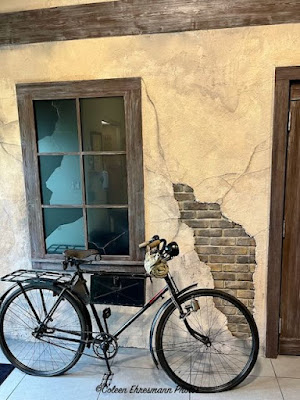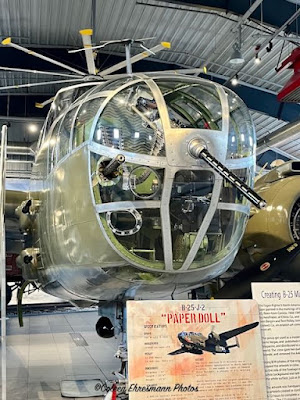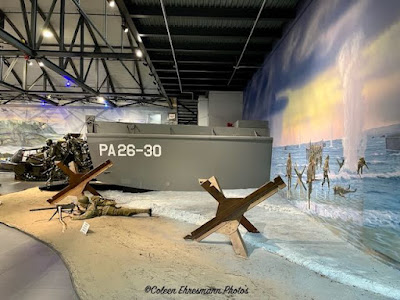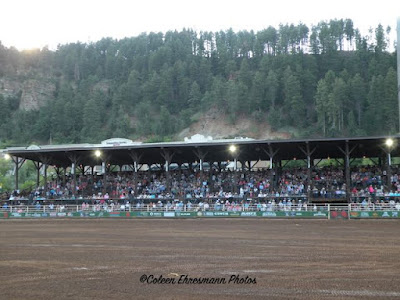The Holocaust display is the first thing you see when you enter the Bomber Hanger.
We are retired educators enjoying the next phase in our lives. Traveling, geocaching and time with family and friends are how we spend our retirement days. We are enjoying the adventures of life after our working years.
Thursday, August 25, 2022
Fagen Fighters WWII Museum - Bomber Hanger
Wednesday, August 24, 2022
Fagen Fighters WWII Museum - Fighter Hanger
The mission of the Fagen Fighters WWII Museum:
Located in Granite Falls, Minnesota, the Fagen Fighters WWII Museum is a showcase of some of the most significant aircraft and ground equipment in that epic conflict. Most importantly, it is a tribute to the men and women of The Greatest Generation whose incredible sacrifices during that time shaped the freedom and liberty we enjoy today. Our mission is to preserve the memory of the heroes of WWII, promote patriotism in today’s Americans, and inspire tomorrow’s leaders to study and apply history’s lessons.
Through our exhibits, programs, and facilities, we hope to instill in all ages the curiosity and desire to learn more about this critical time in the history of the United States.
Preserve History
Promote Patriotism
Inspire the Future
Tuesday, August 23, 2022
Fagen Fighters WWII Museum - The Trainer Hanger
Earlier this summer a friend told us about a fabulous WWII museum in Granite Falls MN. We added it to our summer list of places and included a day of some geocaching. This is one time the geocaching took a second seat. This museum is outstanding and so worthy of a visit by anyone with an interest in WWII.
There are four buildings with plans for a fifth one, just to give you an idea of the size. Because of the number of photos and information, I am dividing it into three parts.
A USO mural and display. Ron Fagen and his wife are in the painted booth on the far right.
Monday, August 22, 2022
Behind the Scenes of a Rodeo
Sorry about the really late follow-up post to the rodeo. this was an OOPS! I forgot it was in the draft file.
I have been attending rodeos since I was a youngster. My Dad liked a good rodeo and if the timing was right on the farm, we would attend one of the performances (usually kids get in free night) July 2-4 of the Sitting Bull Stampede in Mobridge SD. That rodeo has been going on for 77 years; the Deadwood rodeo was 100 years this July.
As much as I enjoy the events of the rodeo, sometimes it is what is happening behind the scenes that is just as interesting. The Deadwood rodeo is structured so attendees can walk along the corrals and see the animals. Parking might be amongst the horse trailers. Families might be camping on the rodeo grounds for most of a week because events start on Wednesday and it takes many hands and bodies to get ready for events as big as the Days of '76.
This family was leaving because the wife got overheated the day before while doing their jobs (helping with the re-enactments) at the Friday rodeo. I watched three horses step into the trailer. I expected a ramp to be lowered, but the horses all stepped right up without any fuss. Once they were secured in their stalls, the family of four climbed in the truck and headed home.
Tuesday, August 2, 2022
The Rodeo: Rides, Rules & Equipment
The rodeo grounds are located in a picturesque setting on the outskirts of Deadwood.
This rider made his 8 second ride and the horse is looking to get out of the arena. You can see how narrow the strap is and how challenging it must be to hold onto the bar when the horse is in bucking mode.
The cowboy holds a rope that is attached to the bottom of the halter of the bronc. The saddle has stirrups and again, the feet of the cowboy must be in position along the withers and kept there until the horse has completed its first buck. (This rule also applies to bareback.) The cowboy's free hand must be in the air and not touch the horse and he must spur the horse throughout the 8 second ride. Scores are based on 50/50. Fifty for the horse and 50 for the rider. One would think if the horse twists and turns it would receive more points. That is NOT the case. Usually if the bronc gets into a smooth rhythm of bucking and moving in a straight line, AND the rider stays on, spurring the horse, the score is higher. Outstanding scores are in the 90s. Usually 80s will be a winning score. If the horse, does not buck coming out of the gate, or if the horse stumbles, the rider can have a re-ride on a different animal. The judges determine the re-ride option and the cowboy can decline if he wants. (This also applies to the Bareback and Bull Riding events.) I have seen low scores in the 60s.
I have seen riders whose hands have been caught in the bull rope as they are bucked off the bull. Until their hand is released, they flop around like a rag doll as the bull continues to buck.




























































